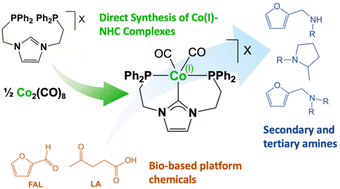Synthesis and catalytic activity of well-defined Co(i) complexes based on NHC–phosphane pincer ligands†
Abstract
A new methodology for the preparation of Co(I)–NHC (NHC = N-heterocyclic carbene) complexes, namely, [Co(PCNHCP)(CO)2][Co(CO)4] (1) and [Co(PCNHCP)(CO)2]BF4 (2), has been developed (PCNHCP = 1,3-bis(2-(diphenylphosphanyl)ethyl)-imidazol-2-ylidene). Both complexes can be straightforwardly prepared by direct reaction of their parent imidazolium salts with the Co(0) complex Co2(CO)8. Complex 1 efficiently catalyses the reductive amination of furfural and levulinic acid employing silanes as reducing agents under mild conditions. Furfural has been converted into a variety of secondary and tertiary amines employing dimethyl carbonate as the solvent, while levulinic acid has been converted into pyrrolidines under solventless conditions. Dehydrocoupling of the silane to give polysilanes has been observed to occur as a side reaction of the hydrosilylation process.



 Please wait while we load your content...
Please wait while we load your content...